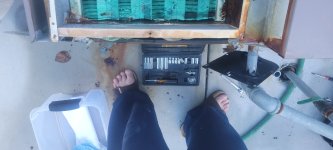Hello!
I'm trying to solve an intermittent "SF" error code on my heater. OK, that's the temperature sensor. It mounts at the left hand edge of the manifold. No big deal, right?
The Hayward service manual lists it as P/N FDXLTER1930. They're all over Ebay & Amazon. OK, I bought one. Went out to install it this morning.
Why won't it screw in? Whups, the old one is DIFFERENT. First of all, it's all plastic. Second, it has an O-ring to seal it instead of goop or teflon tape.
Third, it's SMALLER DIAMETER than my new FDXLTER1930.
Clearly, the FDXLTER1930 is the wrong part for my heater. I websearched till my eyes bugged out, and found nothing else.
Anybody have a clue? The wife wants her pool back, sooner rather than later . I guess I'll be calling Hayward tomorrow.
. I guess I'll be calling Hayward tomorrow.
I'm trying to solve an intermittent "SF" error code on my heater. OK, that's the temperature sensor. It mounts at the left hand edge of the manifold. No big deal, right?
The Hayward service manual lists it as P/N FDXLTER1930. They're all over Ebay & Amazon. OK, I bought one. Went out to install it this morning.
Why won't it screw in? Whups, the old one is DIFFERENT. First of all, it's all plastic. Second, it has an O-ring to seal it instead of goop or teflon tape.
Third, it's SMALLER DIAMETER than my new FDXLTER1930.
Clearly, the FDXLTER1930 is the wrong part for my heater. I websearched till my eyes bugged out, and found nothing else.
Anybody have a clue? The wife wants her pool back, sooner rather than later








